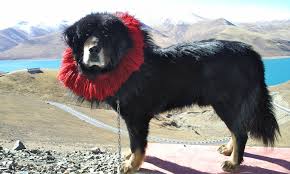Country of Origin: Tibet
History: The Tibetan mastiff is an ancient breed that was used to ruard livestock and property in Tibetan villages, although the breed may have originally come from China. Although this breed is believed to be the progenitor of all mastiffs, it was not exported during modern times until 1847 when Queen Victoria received a Tibetan mastiff as a gift. The first Tibetan mastiff came to the U.S. as a gift to President Eisenhower.

Physical Description: This is a heavy, powerful dog that is longer than it is tall. The broad head is heavily wrinkled with a square muzzle and broad nose. The lips are moderately pendulous and the eyes are brown and slanted. The ears are drop. The long tail curls over the back. The double coat has a dense undercoat and a hard, straight outer coat. The neck, chest, tail and hind legs are feathered. The coat may be black, black and tan, brown, gold, gray, and blue, or gray, blue and tan, with tan markings above the eyes, lower legs, under the tail, on the muzzle, and around the eyes. There may be white markings on the chest and feet.
Height: 24 to 30 inches
Weight: 75 to 160 pounds
Temperament: The Tibetan mastiff is a reserved and independent minded dog that is dominant and often stubborn, with what some call catlike behavior. It is very protective and makes a good guard. It should be supervised with children and other animals as it can be overprotective and May misinterpret benign interactions.
Activity Level: Moderate
Best Owner: The Tibetan mastiff does best with a firm, dog experienced owner in a rural or suburban environment.
Special Needs: Fenced yard, firm training, socialization, leashed
Possible Health Concerns: Ectropion, entropion, hypothyroidism




